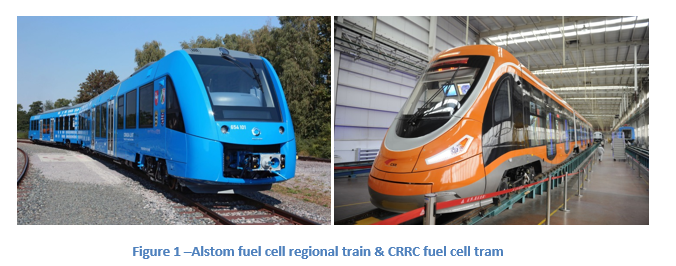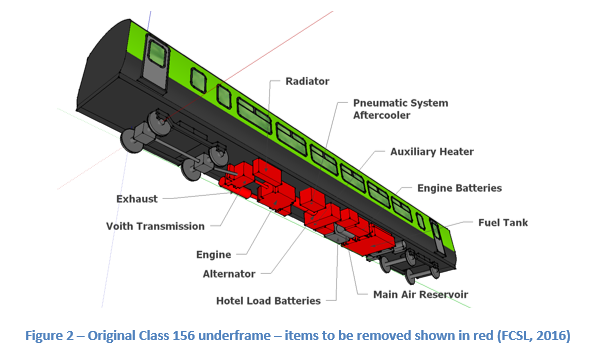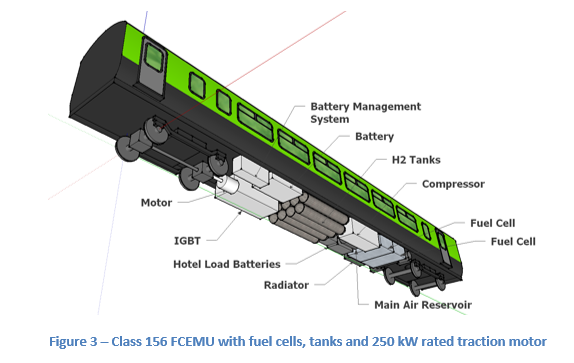Wire-Free Electrification
Stephen Kent
University of Birmingham, UK
The railways are under pressure to increase capacity, reduce operating costs, and cut their contribution to pollution and CO2 emissions. Electrification can help in this respect by providing high performance trains that maximise capacity and reduce pollution in our towns and cities. But electrification is expensive, and while justifiable on heavily used lines, rural and branch lines simply don’t see the levels of traffic and revenue to justify this expense.
There are other issues with electrification including the visual impact of overhead wires and masts, and the disruption that the installation of electrification can cause, particularly where bridge structures and tunnels need to be enlarged. The rail network also consumes a significant proportion of the UK’s overall electricity supply, estimated to be around 3 TWh (ATOC, 2007) per annum for traction out of a total of 331 TWh for the UK as a whole (International Energy Agency, 2016), i.e. approximately 1%. Railways also draw large quantities of power during the morning and evening peaks, and traction loads consume just a single phase from the UK’s 3-phase distribution network, unbalancing the National Grid. With the push to electrify the UK’s mainlines, the burden on Britain’s already stretched generation and distribution networks will increase. So what are the alternatives?
There have been great advances in the efficiency and cleanliness of diesel engines. But with railway vehicles designed to last 30 to 40 years, diesel is not regarded as a long term solution. There is also an increasing issue with diesel trains “holding up” faster Electric Multiple Units (EMUs) wherever they share the same tracks, thereby constraining capacity on Britain’s already congested rail network.
Hybrid EMUs equipped with large battery packs are a viable solution wherever a train spends a good proportion of its duty cycle on electrified lines. While under the wires, energy is used to charge up a large on-board battery pack that then “kicks in” for the un-electrified section of the route. But this isn’t viable for those lines with little or no sections of overhead wires.
But there is an alternative type of traction that is particularly well-suited to Britain’s rural and branch lines. It is a form of electrification, but it involves no overhead wires, and has the advantage of being able to make good use of the country’s ever increasing renewable energy generation.
The UK, like many other countries has introduced a number of fleets of hydrogen fuel cell powered buses, notably in London, Aberdeen and shortly Birmingham. Electrolysers use off-peak, surplus and / or zero carbon energy to generate large quantities of hydrogen that is then stored locally to refuel the fleet. Per vehicle, the energy and power requirements for a bus are remarkably close to those of regional or branch line trains, so it ought to be possible to transfer this technology from buses to trains. Indeed, this is already happening, with Alstom currently building a fleet of fuel cell regional trains for operation in Germany, and CRRC of China developing two different designs of fuel cell powered tram, as shown in Figure 1:
The University of Birmingham has been working with partners Hitachi Rail Europe and Fuel Cell Systems Limited to see whether it would be possible to convert a typical UK mid-life Diesel Multiple Unit (DMU) to a fuel cell powertrain. This project was funded and managed by the UK Railway Standard and Safety Board (RSSB) as part of one of their competitions to support innovation within the industry. The project set out to establish:
- Whether a conversion would be technically possible using commercially available technology;
- Whether the converted train would have sufficient performance and range to meet the requirements for regional and branch line services;
- Whether the conversion makes commercial sense, with anticipated savings in fuel costs justifying the cost of conversion, and of the hydrogen production plant and equipment.
The first stage of the study was to analyse the power and energy storage requirements of a typical train operating on a typical route. The RSSB provided a number of route profiles, and the team chose to concentrate on the Norwich to Sheringham branch line. While admittedly a rather flat part of the UK, this route provided the most demanding duty cycle and a 75mph line speed.
The ambition was to enable continuous operation for 16 hours between refuelling (i.e. more than a typical day’s running), with significantly reduced energy consumption. At a minimum, train performance needed to match existing units, but with train operators increasingly concerned about diesel trains “holding up” faster EMUs, it was felt that the modified DMU ought to aim to provide EMU type levels of performance.
- A number of vehicle models were constructed using the University’s Single Train Simulator. This is a bespoke piece of software written in Matlab that calculates power and energy consumption for rail vehicles over a prescribed route, proven over a number of years for a wide variety of applications. A total of three vehicle models were evaluated over the route:
- A model of the current two-car Class 156 DMU, with approximately 200 kW of installed diesel power per vehicle, mated to a (relatively inefficient) hydraulic transmission;
- A modified Class 156 FCEMU (Fuel Cell Electric Multiple Unit), equipped with hydrogen tanks, fuel cells, a battery pack, traction electronics and various sizes of traction motor;
- A model of Hitachi’s new AT200 EMU to act as a benchmark for performance.
The initial simulations established the basic requirements for the train, which suggested that a fuel cell stack with at least 150 kW and around 60 kg of hydrogen per vehicle would be required. An initial space analysis suggested there was sufficient room on the underframe for the requisite number of 350 bar hydrogen storage tanks, fuel cell system, and a 200 kW traction motor and drive electronics.
The design was then revised to use commercially available technology, including two of Ballard’s 104 kW fuel cell modules per vehicle. This level of installed power, when allied to a fairly substantial battery pack, would provide enough power to drive a standard Hitachi traction motor rated at 250 kW (continuous), capable of developing 330 kW under hard acceleration. Appropriately geared for 75 mph, this would provide EMU levels of acceleration, as well as enabling a good proportion of braking energy to be recovered and reused.
Of course, various other underframe equipment would also need to change, for example swapping the original engine driven compressor for an electrically driven one, and getting rid of the troublesome auxiliary heater used to warm the diesel fuel in cold conditions. The 3D model in Figure 2 shows the original underframe of the Class 156 with those items in red to be removed or replaced:
As it can be seen, with the exception of brake system components, almost all of the underframe equipment would go, leaving a very useable space for the replacement fuel cell powertrain, as shown in Figure 3:
The performance and energy consumption for the revised concept design were re-calculated and compared with both the original Class 156 DMU and a standard 3-car Hitachi AT200 EMU. Energy consumption was calculated on a per-vehicle basis, both in terms of the energy at the driven wheels, and also in terms of energy input to the vehicle (i.e. “fuel energy”). This gave the results summarised in Table 1:
The weight of equipment added to the vehicle was estimated to be around 500 kg lighter than the original powertrain. So it was concluded that it is possible to take an existing Class 156, replace the diesel powertrain with a hybrid fuel cell drive based on commercially available components, and achieve:
- Sufficient operating range to allow for daily refuelling;
- A similar level of performance to a typical modern EMU;
- A 52% reduction in overall energy consumption in terms of fuel input when compared to the original diesel powertrain.
However, there was a further potential technical challenge to be addressed relating to hydrogen production. Most of the current fuel cell bus fleets are relatively small, with there being just 10 vehicles in the Aberdeen fleet for example. A typical fleet of trains would be more like 50 vehicles, each requiring approximately double the quantity of hydrogen of a typical hydrogen powered bus. It was calculated that a fleet of 25 x 2-car multiple units with each doing a more typical 350 duty cycle would require the on-site production of approximately 2000 kg of hydrogen per day. This is hydrogen production on an industrial scale.
The most common way of producing hydrogen in industry is by taking natural gas and splitting out the hydrogen in a process called steam reformation. Skid mounted steam reformation plant is available from companies such as Linde that will produce 500 kg+ per day of hydrogen, so a train fleet would require four such production units.
From an environmental perspective, although still using a fossil fuel, there would actually be a significant reduction in CO2 emissions per annum, from 15,500 tonnes per annum for the diesel fleet to a predicted 8,900 tonnes for the FCEMU fleet. Particulates and NOx would also be virtually eliminated, and of course there would be no load on the national electricity grid, other than relatively low requirements of the pumps, control systems etc. of the hydrogen production plant.
From a cost perspective, the plant and equipment required is not cheap, estimated to be around £12.2m. But the fuel cost savings are impressive, with the per-mile fuel cost dropping by 63% compared to diesel, giving a predicted annual saving of £2.2m for the fleet. This equates to a payback period of around 20 years on fuel savings alone.
However, most fuel cell transport applications actually use electrolysers to generate the hydrogen required. Electricity is used to split water into hydrogen and oxygen, typically using off-peak or surplus electrical energy from the National Grid. This has the potential to help balance the grid by consuming 3-phases rather than one, and using only off-peak power to generate the hydrogen. It also provides the increasingly valuable ability to make use of intermittent renewable energy sources such as wind, assuming there is sufficient on-site hydrogen storage capacity.
The calculations showed that 9 of the latest generation 1MW electrolysers from Siemens would be required to generate 2000 kg, based on off-peak operation 12 hours per day. In terms of cost, the plant and equipment would be slightly more expensive, and CO2 emissions would actually increase from 15,500 tonnes for diesel to 20,600 tonnes per annum for the fleet for electrolysis. However, this calculation was based on the average CO2 emissions per kWh according the UK’s electricity generation mix in 2015. This value is currently falling as a result of various national initiatives to reduce carbon emissions in power generation. There is of course also the potential to use renewables or other zero-carbon sources to generate hydrogen to achieve truly zero-carbon, zero emission power.
The calculation of operating costs for electrolysis is considerably more difficult to predict with any confidence than for natural gas. While the railways currently pay around 11 pence per kWh for traction energy (based on the blended rate for charter train services), it is likely that a significantly lower price could be negotiated for 3-phase, off-peak electricity. Indeed, if the railway network in question is located in an area with a large number of local wind farms, Cardiff’s Core Valley Lines being a good example, there is the possibility of using low cost excess wind energy. As mentioned above, this would require considerable local hydrogen storage capacity, but then town gas is largely composed of hydrogen, and it used to be commonplace to store huge quantities of this in gasometers.
Conclusions & Further Inspiration
The main conclusion from the study was that it is perfectly possible to convert a 75mph regional train from diesel to fuel cell power using commercially available technology. The converted train would achieve a substantial improvement in performance, a drastic cut in energy consumption and associated fuel costs, and a significant reduction in emissions. However, the cost of conversion is high, particularly when you include the plant and the equipment required to generate hydrogen on-site. So re-engineering a mid-life fleet such as the Class 156s is unlikely to make commercial sense unless there is a local supply of cheap electricity and government support for the hydrogen production plant and equipment.
However, looking at the costs as an alternative to electrification, one might well arrive at a different conclusion. Taking the Core Valley Lines in Wales as an example, the estimated cost of electrification is £300m. Suddenly, the overall cost of converting a fleet of around 30 multiple units and installing hydrogen production facilities starts to look like very good value at around £50m to £60m.
But an even better target for fuel cells could well be trams. These do a significantly lower daily mileage than a regional train, and can make greater use of regenerative braking, so the overall on-train hydrogen storage requirements would be substantially lower. This of course cuts the size and cost of the hydrogen production plant and equipment, and going wire-free avoids the need for both expensive catenary and sub-stations, and removes the need to electrically isolate the rails from the ground. As existing trams typically use a 700 VDC overhead supply, conversion to fuel cell operation ought to be relatively straightforward, and planning permission for infrastructure works for new or extended routes much easier to obtain.
It is interesting to note that Birmingham’s fleet of new trams from the Spanish manufacturer CAF are currently being equipped with roof mounted traction batteries. The intention is to enable these trams to make short hops “off the wires” wherever it is necessary or cost effective to do so. This can include locations that are architecturally sensitive, or where putting up wires is awkward or expensive – complex road traffic junctions and tunnels being two prime examples. But wouldn’t it be better to install a fuel cell on the roof and not have to put wires up at all?
Works Cited
ATOC. (2007). Baseline Energy Statement - Energy Consumption and Carbon Dioxide Emission on the Railway.
International Energy Agency. (2016). Key World Energy Statistics.
 Stephen Kent spent 16 years in the UK rail industry prior to joining the University’s Railway Centre as a Teaching / Research Fellow. He has a number of research interests that include the use of fuel cells for both static and traction applications, and the application of additive manufacturing to train and infrastructure maintenance and repair. His enthusiasm for fuel cells started when he managed the development of the UK’s first fuel cell powered locomotive, the Hydrogen Pioneer, and he subsequently lead the team that undertook the study discussed in this article.
Stephen Kent spent 16 years in the UK rail industry prior to joining the University’s Railway Centre as a Teaching / Research Fellow. He has a number of research interests that include the use of fuel cells for both static and traction applications, and the application of additive manufacturing to train and infrastructure maintenance and repair. His enthusiasm for fuel cells started when he managed the development of the UK’s first fuel cell powered locomotive, the Hydrogen Pioneer, and he subsequently lead the team that undertook the study discussed in this article.
About the Newsletter
Editors-in-Chief

Jin-Woo Ahn
Co-Editor-in-Chief

Sheldon Williamson
Co-Editor-in-Chief
TEC Call for Articles 2023 - Advances in Charging Systems
The TEC eNewsletter is now being indexed by Google Scholar and peer-reviewed articles are being submitted to IEEE Xplore.
To submit an article click here.






